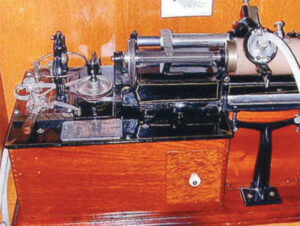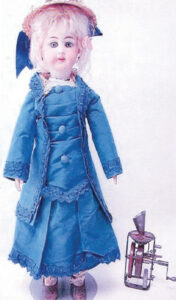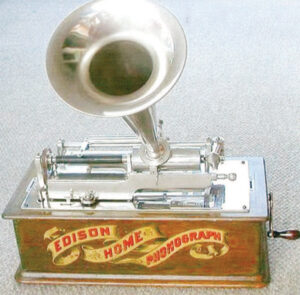 By Maureen Timm
By Maureen Timm The first great invention developed by Edison in Menlo Park was the tin foil phonograph. While working to improve the efficiency of a telegraph transmitter, he noticed that the tape of the machine gave off a noise resembling spoken words when played at a high speed. This caused him to wonder if he could record a telephone message. He began experimenting with the diaphragm of a telephone receiver by attaching a needle to it. He reasoned that the needle could prick paper tape to record a message. His experiments led him to try a stylus on a tinfoil cylinder, which, to his great surprise, played back the short message he recorded, “Mary had a little lamb.”
The word phonograph was the trade name for Edison’s device, which played cylinders rather than discs. The machine had two needles: one for recording and one for playback. When you spoke into the mouthpiece, the sound vibrations of your voice would be indented onto the cylinder by the recording needle. This cylinder phonograph was the first machine that could record and reproduce sound created a sensation and brought Edison international fame.
August 12, 1877 is the date popularly given for Edison’s completion of the model for the first phonograph. He toured the country with the tin foil phonograph, and was invited to the White House to demonstrate it to President Rutherford B. Hayes in April 1878.
 In May 1889, the first “phonograph parlor” opened in San Francisco. Customers would sit at a desk where they could speak through a tube, and order a selection for one nickel. Through a separate tube connected to a cylinder phonograph in the room below, the selection would then be played. By the mid-1890s, most American cities had at least one phonograph parlor.
In May 1889, the first “phonograph parlor” opened in San Francisco. Customers would sit at a desk where they could speak through a tube, and order a selection for one nickel. Through a separate tube connected to a cylinder phonograph in the room below, the selection would then be played. By the mid-1890s, most American cities had at least one phonograph parlor.By 1890, record manufacturers had be-gun using rudimentary duplication process to mass-produce their product. While the live performers recorded the master phonograph, up to ten tubes led to blank cylinders in other phonographs. Until this development, each record had to be custom-made. Before long, a more advanced pantograph-based process made it possible to simultaneously produce 150 copies of each record.
However, as demand for certain records grew, popular artists still needed to re-record and re-re-record their songs. Reportedly, the medium’s first major African-American star, George Washington Johnson, was obliged to perform his “The Laughing Song” more than fifty times in a day, at twenty cents per rendition. (The average price of a single cylinder in the mid-1890s was about fifty cents.)
Businessman Jesse H. Lippincott assumed control of the phonograph companies by becoming sole licensee of the American Graphophone Company and by purchasing the Edison Phonograph Company from Edison. In an arrangement which eventually included most other phonograph makers as well, he formed the North American Phonograph Company on July 14,1888.
Lippincott saw the potential use of the phonograph only in the business field and leased the phonographs as office dictating machines to various member companies which each had its own sales territory. Unfortunately, this business did not prove to be very profitable, receiving significant opposition from stenographers.
 EDISON’S PHONOGRAPH DOLL
EDISON’S PHONOGRAPH DOLL Meanwhile, the Edison Factory produced talking dolls in 1890 for the Edison Phonograph Toy Manufacturing Co. The dolls contained tiny wax cylinders. Edison’s relationship with the company ended in March of 1891, and the dolls are very rare today.
Edison’s Talking Doll was an historic step in phonograph history – the first phonograph marketed for home entertainment, with a pre-recorded cylinder.
The original price was $10 with a simple chemise and $20-$25 with full dress. This was a huge sum for the time, equal to about two week’s salary for the average person. The phonograph inside the body of the doll was tiny, with a small horn pointing up toward holes in the doll’s chest.
The Edison Phonograph Works also produced musical cylinders for coin-slot phonographs which some of the subsidiary companies had started to use. These proto-“jukeboxes” were a development which pointed to the future of phonographs as entertainment machines. In the fall of 1890, Lippincott fell ill and lost control of the North American Phonograph Co. to Edison, who was its principal creditor. Edison changed the policy of rentals to outright sales of the machines, but changed little else.
Edison increased the entertainment offerings on his cylinders, which by 1892 were made of a wax known among collectors today as “brown wax.” Although called by this name, the cylinders could range in color from off-white to light tan to dark brown. An announcement at the beginning of the cylinder would typically indicate the title, artist, and company.
In January 1896, he starred the National Phonograph Company which would manufacture phonographs for home entertainment use. Within three years, branches of the company were located in Europe. Under the aegis of the company, he announced the Spring Motor Phonograph in 1896, followed by the Edison Home Phonograph, and he began the commercial issue of cylinders under the new company’s label.
A year later, the Edison Standard Phonograph was manufactured and then exhibited in the press in 1898. This was the first phonograph to carry the Edison trademark design. Prices for the phonographs had significantly diminished from its early days of $150 (in 1891) down to $20 for the Standard model and $7.50 for a model known as the Gem, introduced in 1899.
Standard-sized cylinders, which tended to be 4.25″ long and 2.1875″ in diameter, were 50 cents each and typically played at 120 r.p.m. A variety of selections were featured on the cylinders, including marches, sentimental ballads, negro songs, hymns, comic monologues and descriptive specialties, which offered sound reenactments of events.
The Edison Concert Phonograph, which had a louder sound and a larger cylinder measuring 4.25″ long and 5″ in diameter, was introduced in 1899, retailing for $125 and the large cylinders for $4. The Concert Phonograph did not sell well, and prices for it and its cylinders were dramatically reduced. Their production ceased in 1912.
A process for mass-producing duplicate wax cylinders was put into effect in 1901. The cylinders were molded, rather than engraved by a stylus, and a harder wax was used. The process was referred to as Gold Moulded, because of a gold vapor given off by gold electrodes used in the process. Sub-masters were created from the gold master, and the cylinders were made from these molds. From a single mold 120 to 150 cylinders could be produced every day. The new wax used was black in color, and the cylinders were initially called New High Speed Hard Wax Moulded Records until the name was changed to Gold Moulded. By mid-1904, the savings in mass duplication was reflected in the price for cylinders which had been lowered to 35 cents each. Beveled ends were made on the cylinders to accommodate titles.
The Edison business phonograph finally became a dictating system. Three machines were used: the executive dictating machine, the secretarial machine for transcribing, and a shaving machine used to recycle used cylinders. This system can be seen in the Edison advertising film, “The Stenographer’s Friend,” filmed in 1910. An improved machine, the Ediphone, was introduced in 1916 and steadily grew in sales after World War I and into the 1920s.
In 1913 Edison announced the manufacture of the Edison Disc Phonograph. The Edison Company did not desert its faithful cylinder customers, however, and continued to make Blue Amberol cylinders until the demise of the company in 1929.
From the mid-1890s until the early 1920s both phonograph cylinder and disc recording and machines to play them on were widely mass-marketed and sold. The disc system gradually became more popular due to its cheaper price and better marketing by disc record companies. Edison ceased cylinder manufacture in the fall of 1929, and the history of disc and cylinder rivalry was concluded.
OLDEST SURVIVING RECORDINGS
1) Frank Lambert’s lead cylinder recording of an experimental talking clock is thought to be both the oldest surviving sound recording and the oldest surviving playable recording.
2) A recording of a speech by Lord Stanley at the 1888 Toronto Agricultura1 Fair.
3) A recording of Handel’s choral music from June 29, 1888 at The Crystal Palace in London (the oldest surviving musical recording) These last two sound recordings survived because they were re-recorded onto later formats.















Follow Us